108 - Endoluminal Management of Malignant Airway Disease
Editors: Shields, Thomas W.; LoCicero, Joseph; Ponn, Ronald B.; Rusch, Valerie W.
Title: General Thoracic Surgery, 6th Edition
Copyright 2005 Lippincott Williams & Wilkins
> Table of Contents > Volume II > The Esophagus > Section XIX - Physiology > Chapter 125 - Physiology and Physiologic Studies of the Esophagus
Chapter 125
Physiology and Physiologic Studies of the Esophagus
Andr C.H. Duranceau
Pasquale Ferraro
NORMAL ESOPHAGEAL FUNCTION
Pharynx
The function of the pharynx has received less attention than that of the esophagus, partly because water-infused systems do not accurately measure pressure events in the pharynx. Dodds and associates (1975), however, measured pharyngeal contractions in human subjects using intraluminal strain gauges and found average contraction pressures of 200 mm Hg, with pressures recorded up to 600 mm Hg. The pharyngeal contraction lasts about 0.2 to 0.5 seconds. The rapidity of the pharyngeal contraction wave (9 25 cm/s) requires it to be recorded in this fashion. Frequently, before the single pharyngeal peak, an initial increase in pressure occurs. This increase is usually thought to be caused by the tongue thrust, the trapped air column, or the advancing bolus.
Upper Esophageal Sphincter
The upper esophageal sphincter (UES) is a high-pressure zone that separates the pharynx from the esophagus. Its most important role may be to prevent esophagopharyngeal regurgitation; gastroesophageal reflux occurs in normal individuals, and the sphincter may prevent the regurgitation of gastric contents into the pharynx. The sphincter may also have a role in preventing the entry of air into the esophagus, although this probably is not an important function.
The cricopharyngeus is a muscle sling attached posteriorly to both laminae of the cricoid cartilage. The configuration and location of this muscle give it a role similar to that of the bowstring, with tension exerted mostly in the anteroposterior direction. Winans (1972) documented this asymmetry within the sphincter. Using an eight-lumen catheter with all recording ports arranged circumferentially at the same level, he observed pressures of 100 mm Hg in the anteroposterior position and 30 mm Hg in the lateral orientation (Fig. 125-1).
It is generally agreed that the cricopharyngeus is the major component of the UES. This muscle is approximately 1 cm long, however, so it cannot account totally for the 2- to 3-cm width of the high-pressure zone of the UES recorded by Winans (1972) and Welch and colleagues (1979).
As suggested by Airdar (1943), passive elastic forces may play a role in the maintenance of closure of the UES in humans. From the investigations of Asoh and Goyal (1978), this certainly appears to be true in the opossum, in which a residual closing pressure remains in the anteroposterior direction after removing the nervous supply to the sphincter muscle. Nevertheless, UES pressure is probably predominantly a result of tonic muscle contraction. Shipp and co-workers (1970) recorded sustained electromyographic activity from the cricopharyngeus muscle in humans.
Sokol and associates (1966) reported that during swallowing, the UES moves vertically approximately 2 cm. This movement has led to methodologic problems in the study of UES function using a perfused side-hole catheter. Gerhardt (1978) and Welch (1979) and their colleagues, sampling via rapid pull-through techniques in normal controls, recorded anteroposterior basal tone in the range of 100 to 130 mm Hg.
Adaptation by Dent (1976) and Kahrilas and associates (1987a) of the sleeve manometric technique for the study of the UES has provided further insights into UES function. Basal UES pressure was found by Kahrilas and colleagues (1987b) to decrease during sleep to a level of 6 to 13 mm Hg, whereas in awake subjects it was approximately 60 mm Hg.
Relaxation of the UES that allows the passage of material through it appears to occur with the onset of swallowing (Fig. 125-2), and as noted by Kahrilas and associates (1986a), it also occurs independent of swallowing to allow belching. Several stimuli that increase UES tone have been studied, including balloon distention in the esophagus, reported by
P.1906
Creamer and Schlegel (1957) and Gerhardt (1978) and Kahrilas (1987b) and their colleagues. Also studied were acidification of the esophageal lumen, recorded by Gerhardt and associates (1978), and slow, intraesophageal gas insufflation (as opposed to rapid distention) that produces relaxation, as noted by Kahrilas and co-workers (1986a).
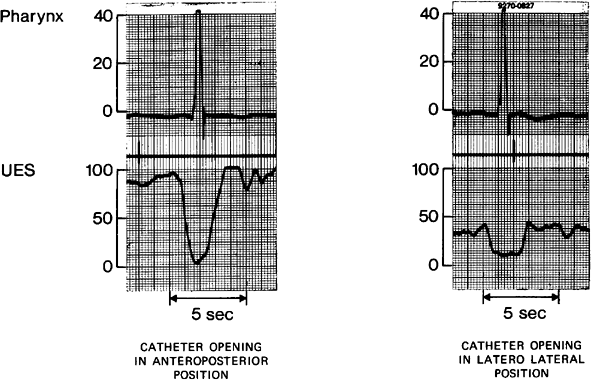 |
Fig. 125-1. Irregular configuration of sphincters makes single-port recording inaccurate because of position. Sleeve recording (Dent) or circumferential microtransducers (Castell) offer more accuracy in pressure readings. UES, upper esophageal sphincter. |
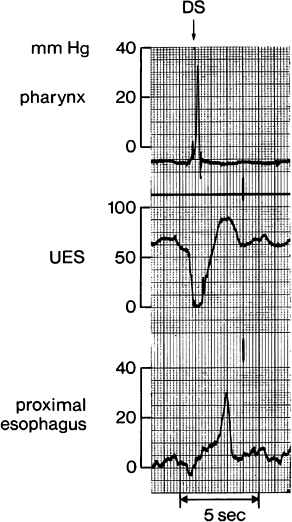 |
Fig. 125-2. Function of the normal pharyngoesophageal junction. The pharynx contracts with a single peak lasting 0.2 to 0.5 seconds. The upper esophageal sphincter (UES) is a high-pressure zone at rest that relaxes to cervical esophageal baseline pressure. Passage of the pharyngeal wave toward the cervical esophagus provides sphincter-closing pressures. Primary peristalsis then appears in the infrasphincteric portion of the proximal esophagus. DS, dry swallow. |
A contraction of the high-pressure zone is observed after UES relaxation. It occurs with the progression of the pharyngeal contraction toward the cervical esophagus. This closing pressure may increase the sphincter pressure to twice its resting pressures. Baseline pressures then return in the sphincter, and contraction continues as primary peristalsis in the cervical esophagus (see Fig. 125-2).
Esophageal Body
The musculature of the esophageal body is not tonically contracted. The role of the longitudinal muscle in esophageal function is difficult to study. Sugarbaker and colleagues (1984) have suggested that it may improve the mechanical properties of the esophagus for bolus transport. The circular muscle, however, is much easier to study because of its lumen-occluding contraction, which passes down the esophageal body, pushing contents ahead of it.
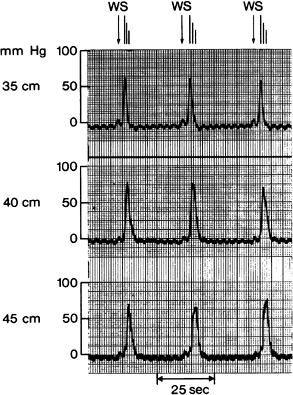 |
Fig. 125-3. Normal peristalsis in the esophageal body, after voluntary deglutition of a water bolus. The wave travels aborally (away from the mouth) and is seen as it passes by each recording port. WS, wet swallow. |
P.1907
Primary peristalsis is triggered voluntarily by swallowing but thereafter is not under voluntary control (Fig. 125-3). Not all peristaltic waves are complete in normal subjects. In response to dry swallows, complete waves occur on only approximately two thirds of occasions. Specific patterns can be observed, such as the peristaltic fade-out at the aortic arch level. Tertiary contractions in the distal esophagus can be recorded in response to deglutition (Figs. 125-4 and 125-5). Occasionally, no detectable wave can be seen in response to swallows, as reported by Dodds and co-workers (1973) and Hollis and Castell (1974). As one of us (AD) and associates (1983b) noted, however, water swallows produce more complete peristaltic sequences. Other factors that may influence primary peristaltic activity are posture and age: a decrease in amplitude is seen when the subject is supine and in men over the age of 80 years, as reported by Kaye and Wexler (1981) and Hollis and Castell (1974).
The esophageal wave travels down the esophageal body at a speed of 2 to 5 cm/s. The wave of contraction that occurs in response to deglutition progresses slowly in the proximal striated muscle area. It slows further at the striated smooth muscle junction and then accelerates in the lower half of the esophagus, except just above the lower sphincter, where it is seen to slow again (see Fig. 125-3). In a similar fashion, peak contraction pressures are weak in the striated esophagus and stronger in the distal esophagus. The values obtained in recording esophageal body motility vary from source to source, and the influence of different recording techniques is well documented.
Peristaltic sequences can also be modified by the rate of swallowing. Swallows at 5-second intervals or less tend to inhibit peristalsis completely; only when swallows are taken at greater than 20-second intervals do completely normal sequences occur, as reported by Ask and Tibbling (1980) and Meyer and colleagues (1981).
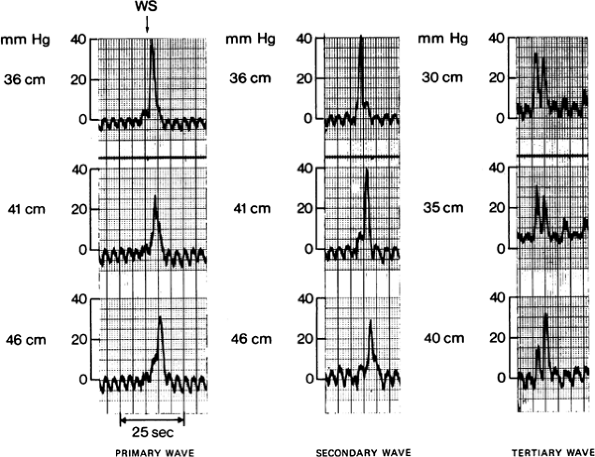 |
Fig. 125-4. The three types of contractions in the esophagus. The primary wave is the normal response of the esophagus to voluntary swallowing. The secondary wave is a normal peristaltic wave that occurs in response to distention or irritation. The tertiary wave is nonpropulsive. It occurs in response to swallowing or appears spontaneously. WS, wet swallow. |
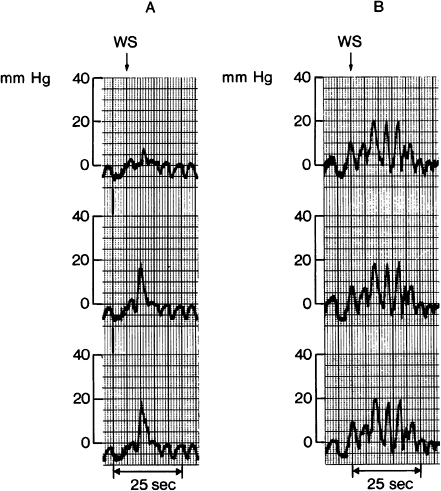 |
Fig. 125-5. A. Single tertiary contraction in response to a voluntary swallow. B. Repetitive nonpropulsive activity after deglutition. WS, wet swallow. |
P.1908
The control of primary peristalsis is complex. The striated muscle is probably directly controlled by the nucleus ambiguus through the vagus, whereas the smooth muscle portion is probably controlled by a combination of extrinsic vagal and local neural control. Both cholinergic excitatory and nonadrenergic, noncholinergic inhibitory mechanisms were suggested by Christensen (1970), as well as by Sarna (1977) and Crist (1984) and their co-workers, to be involved in normal peristalsis.
Secondary peristalsis refers to peristaltic waves that are not controlled by swallowing but usually are in response to esophageal distention or irritation. These secondary waves, which have been studied less extensively than primary peristaltic contractions, probably have a housekeeper role in clearing refluxed material from the esophagus (see Fig. 125-4).
Tertiary contractions (Fig. 125-6; also see Figs. 125-4 and 125-5) can be abnormal contractions occurring in response to swallowing (see Figs. 125-5 and 125-6), or they can appear spontaneously between swallows (see Figs. 125-4 and 125-6). Rubin (1962) suggested a relationship between esophageal motor disorders and the emotional states of patients during recordings. Nonpropulsive contractions and repetitive spontaneous contraction were observed when motor function of the esophageal body was recorded during affectively charged conversation. Spontaneous tertiary contractions occur in healthy individuals but are observed more often in patients with a strongly anxious personality (see Figs. 125-4 to 125-6).
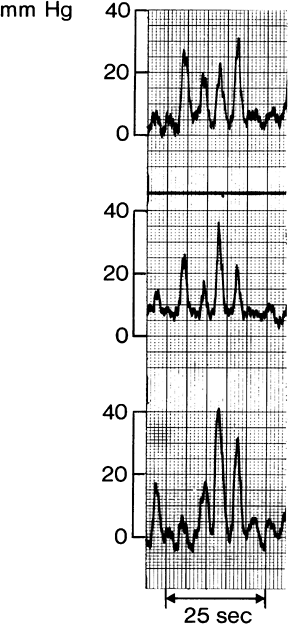 |
Fig. 125-6. Spontaneous tertiary activity appearing without swallow. |
Lower Esophageal Sphincter
It is now accepted that there is both a physiologic lower esophageal sphincter (LES), as emphasized by Dodds and associates (1981), and an anatomic LES, as documented by Liebermann-Meffert and colleagues (1979), and that the maintenance of basal tone is the major mechanism preventing gastroesophageal reflux (Fig. 125-7).
Winans (1977) has pointed out that the pressure profile of the LES shows considerable radial asymmetry, with the highest pressures being recorded in the left posterior orientation. The reasons for this asymmetry are not clear. As with the UES, the LES relaxes to allow passage of luminal contents in either direction, relaxation occurring with peristaltic activity in the esophageal body or gaseous distention in the fundus of the stomach.
The mechanisms underlying the control of basal tone in the LES are not well understood. Fisher (1977) and Dodds (1981) and their co-workers wrote that cholinergic vagal drive seems a likely candidate, at least in part. Circulating hormones, such
P.1909
as gastrin, are considered less likely to contribute to basal tone. Basal tone varies greatly in normal individuals. In the fasting state, the migrating motor cycle may influence LES pressure, which tends to increase during the cycle, as recorded by Dent and associates (1983), and can reach high levels during phase III gastric contractions. Basal tone rises during increases in intraabdominal pressure; it remains controversial whether this change is a reflex rise in pressure or an increased diaphragmatic compression of the LES, as suggested by Boyle and Cohen (1984). Perhaps the evidence, as reported by Landers and Jamieson (1987), is beginning to favor the involvement of a reflex.
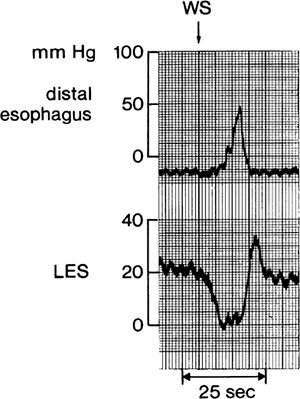 |
Fig. 125-7. Normal lower esophageal sphincter (LES). Relaxation of the sphincter anticipates the oncoming peristaltic wave. Arrival and passage of the contraction through the sphincter area closes the sphincter before a return to normal baseline pressures. WS, wet swallow. |
Relaxation of the LES occurs with swallowing, with esophageal body distention, and with gastric fundus distention. Transient LES relaxation (TLESR) is a phenomenon of relaxation lasting 5 to 30 seconds described by Dent and colleagues (1980). These TLESRs probably arise as a result of gastric distention leading to nonadrenergic, noncholinergic inhibition of the LES tone. As suggested by Dent (1980) and Dodds (1982) and associates, such LESRs may be the most important factor in both physiologic and pathologic reflux.
Other factors that should be mentioned, as noted by Bonavina and colleagues (1986), as contributing to pressure in the LES region are extrinsic compression by diaphragmatic muscle, which is probably most important during straining, and the intraabdominal position of the LES, which allows intraabdominal pressure changes to buttress the LES.
THE VARIABLES AFFECTING THE RECORDING OF ESOPHAGEAL MOTILITY
Accurate recording of the physiologic events that occur with swallowing leads to an understanding of the pathophysiologic mechanisms of esophageal disorders. Although initial motility studies were mostly oriented toward research, motor function evaluation is now considered essential in the assessment of esophageal disease.
Esophageal motility studies record pressures simultaneously at several levels within the esophagus, allowing evaluation of the esophageal body and of the sphincters that close the upper and lower ends of the esophagus.
Intraluminal manometry is the method best suited for the study of motility in humans. Technical refinements in the past two decades, discussed by Dodds (1976) and one of us (AD) and colleagues (1983b) and more recently by Castell and co-workers (1987), have led to greatly improved capability for accurate measurement with current techniques.
Meticulous attention to the recording method and the numerous factors that may affect it is necessary. For this reason, it is important to have a control population evaluated with the local recording technique. This effort ensures more accuracy and gives a better perspective of what can be interpreted as normal in a patient population (Fig. 125-8). The recording system used is usually water perfused, and the patient is supine while studied.
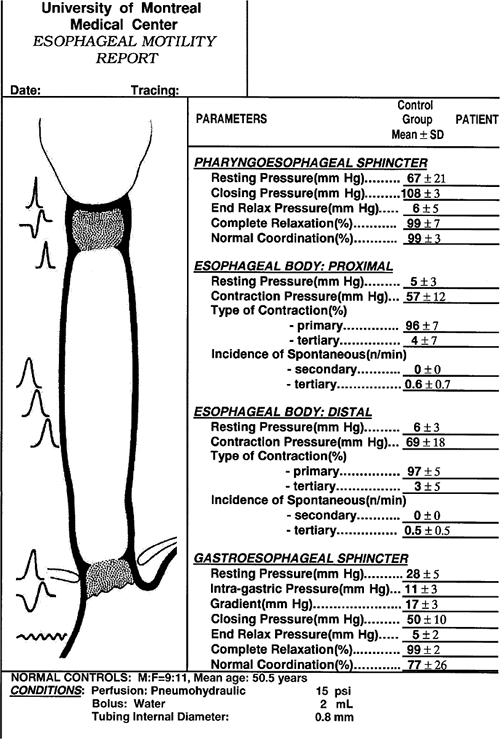 |
Fig. 125-8. Motor function assessment with control population for comparison with patients. |
The preferred system of fluid-filled catheter manometry includes a pneumohydraulic infusion pump and small (0.8-mm internal diameter) polyvinyl tubing. This system reduces the high infusion rate required to record accurately the rapidly changing pressures when using a mechanically driven pump with syringes. Table 125-1 summarizes the variables that may affect recording of esophageal physiology and its interpretation.
Constantly perfused catheters ensure reliability in the pressures recorded. Without perfusion, considerable variability is observed from patient to patient. If mechanical perfusion is used, Pope (1970) reported that the infusion rate shows a direct influence on pressure values. To overcome the inconvenience of infusing high volumes of fluid during a study and to allow more accurate changes in pressure over time ( P/ T) a constant-pressure infusion system was developed by Arndorfer and colleagues (1977). It pushes small volumes of water through a noncompliant system and is now used more readily. Intraesophageal microtransducers are accurate and easy to use. Their initial cost and their maintenance
P.1910
and repair expenses, however, have proved a major disadvantage to their routine use (Fig. 125-9).
Table 125-1. Variables Affecting Esophageal Pressure Recordings | |||||||||||||||||||||||||||||||||
|---|---|---|---|---|---|---|---|---|---|---|---|---|---|---|---|---|---|---|---|---|---|---|---|---|---|---|---|---|---|---|---|---|---|
|
The size of the motility tube influences the recorded pressures, with an increase in size leading to an increase in the pressure recorded. The length of the recording tube may impose a dragging effect on the system and result in lower recorded pressures.
Both esophageal sphincters have an irregular configuration and exhibit vertical movement during deglutition. Special attention to these areas is required if reliable recordings are to be obtained. Dent (1976) devised a 5-cm long, perfused sleeve that provides reliable LES pressure measurements despite esophageal movement. A similar sleeve catheter was developed by Kahrilas and colleagues (1987a) for the study of the UES. This catheter follows the sleeve principle and permits reliable recording despite movement of the catheter in the sphincter. The result is optimal pressure readings within the sphincter. Despite more accurate recording of pressures in both sphincters, interpretation of relaxation and coordination of these areas remains to be improved.
It is best to leave an interval of at least 30 seconds between swallows; this timing ensures better organization of contractions. Dry swallows may not initiate contractions or may result in weaker contraction, whereas liquid boluses provide longer and stronger contractions. Solids may result in even more prolonged and vigorous waves. Winship and associates (1970) and Funch-Jensen and Jacobsen (1981) showed that a cold bolus can abolish contraction. Artifacts that frequently modify esophageal motility recordings are coughing, gagging, yawning, eructation, deep inspiration, and Valsalva's maneuver (Figs. 125-10 and 125-11).
It is important to stress that the manometric recording technique and the method of scoring motor events should be carefully standardized to retain meaningful observations. Three firm indications exist for the use of esophageal
P.1911
manometry: (a) documentation of esophageal function in patients with suspected motor disorders, especially those with dysphagia and negative radiographic and endoscopic evaluations; (b) evaluation of patients with chest pain of undetermined origin and in whom coronary artery disease has been ruled out; and (c) documentation of physiologic abnormalities in patients with gastroesophageal reflux.
 |
Fig. 125-9. Effect of perfusion on accuracy of pressure recording. A. At upper sphincter level. B. In the esophageal body. C. At lower esophageal sphincter level. A mechanical pump with syringes requires high infusion rates. A pneumohydraulic pump provides constant pressure infusion with low volumes. |
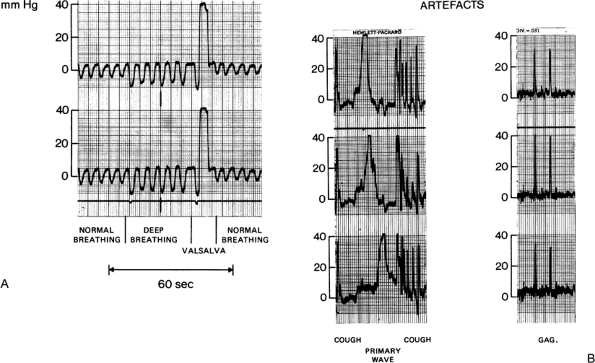 |
Fig. 125-10. A. Influence of respiration. In the esophagus, normal breathing causes a negative deflection and a positive pressure on expiration. Deep breathing increases the negative pressure, whereas forced expiration or effort against a closed glottis (Valsalva's maneuver) increases pressure significantly. These changes may be exaggerated in emphysema and asthma patients. B. Cough and gag are frequent artifacts that are to be distinguished from spontaneous tertiary activity. |
THE INTERPRETATION OF ESOPHAGEAL MOTILITY TRACINGS
Careful high-quality measurements in a quiet and well-controlled environment are essential if meaningful observations and precise diagnosis of esophageal disorders are to be obtained.
 |
Fig. 125-11. Interpretation of pressure recording at the esophagogastric junction. In the high-pressure zone between stomach and esophagus (lower esophageal sphincter) the respiratory inversion point causes a change in the pressure signal at the diaphragmatic level. EI, end-inspiratory pressure; EE, end-expiratory pressure. |
Interpretation criteria are essential because esophageal motility recordings have so many influence factors, as discussed in the previous section. The recorders used to assess esophageal motor function can be a standard physiograph where each recording is then analyzed following preestablished interpretation criteria. New motor function recorders include computerized interpretation programs that follow these same preestablished criteria and deliver the functional results obtained with the recording of both sphincters and of the esophageal body.
Upper Esophageal Sphincter
Ten swallows are measured and all values obtained are averaged. The baseline pressures in the high-pressure zone
P.1912
between the pharynx and the cervical esophagus are recorded. The upper sphincter relaxes completely to cervical esophageal baseline pressure. The end relaxation pressure is recorded with the relaxation. The UES closing pressure is seen and recorded as the peak relaxation augmentation. Coordination is seen as normal when the whole phase of the UES relaxation accommodates the whole duration of pharyngeal contraction and the peak pharyngeal pressure (see Fig. 125-2). Pressure recordings in the UES can be measured accurately with a circumferential microtransducer and with a UES sleeve catheter. Interpretation of coordination on motility tracings is less accurate and has to be correlated with video-radiology recordings.
Esophageal Body
Depending on the number of recording ports of the esophageal motility catheter, the whole length of the esophageal body can be recorded in 10 successive swallows. Esophageal body motor function can also be recorded separately in its proximal and distal portions when three or four recording ports are placed under the UES and above the LES (see Fig. 125-3). The resting pressure in the esophagus is recorded between swallows. The peak contraction pressure is measured, and mean values of the amplitude are obtained from each orifice. Averages can be obtained for the proximal and distal esophagus. Duration of the contraction is the length of time between the upstroke of the contraction and where the downstroke comes back to baseline. The velocity measures how fast the wave moves down the esophagus. From the upstroke points between two recording ports 10 cm apart, the distance is divided by the time it takes the wave to reach the distal port, giving the distance traveled per second. Peristaltic contractions in response to swallowing (primary waves) and spontaneous peristaltic contractions (secondary waves) are recorded separately (see Fig. 125-4). Tertiary contractions are also recorded as occurring in response to swallowing or spontaneously. Double-peaked contractions are seen as a variant of normal: in these waves the higher peak is used for interpretation of the propulsion. Triple-peaked contractions are abnormal and can be numbered separately. Simultaneous contractions (tertiary) occurring after voluntary swallows are usually abnormal (see Fig. 125-5). Spontaneous tertiary activity (see Fig. 125-6) in between voluntary deglutitions are seen frequently, and their frequency may be affected by a number of influence factors, including anxiety and stress (see Table 125-1). When interpreting propulsion, the upstroke of the contraction is seen as the onset of the tightening of the esophageal muscle over the proximal part of the swallowed bolus. When a wet swallow is followed by no activity, this is a failed or nontransmitted wave. Contraction responses of less than 30 mm Hg are considered ineffective. A resting period of at least 30 seconds between swallows ensures the elimination of deglutitive inhibition with the muscle refractory period.
Lower Esophageal Sphincter
Measurements in the LES are made either using a rapid pull-through technique or a stationary slower and more progressive method. Five swallows are recorded at each port and averaged for better accuracy. The resting intragastric pressure and the peak resting pressure in the sphincter are recorded at the midpoint of the inspiration-expiration phases. Intragastric pressure is subtracted from the absolute LES resting pressure, providing a gradient between the esophagus and the gastric cavity. The peak closing pressure of the sphincter is recorded (see Fig. 125-7). Relaxation of the LES is considered normal, with a complete decrease of the LES resting pressure to resting intragastric pressure. This should occur in 100% of the wet swallows. The report of the motor function in any patient should be made with a control population for the laboratory where the recording is analyzed (see Fig. 125-8).
CLASSIFICATION AND SPECTRUM OF PHYSIOLOGIC ABNORMALITIES IN THE ESOPHAGUS
Esophageal motor disorders can be subdivided into three areas. Oropharyngeal dysphagias result from dysfunction at the pharyngoesophageal junction, the etiology of which is summarized in Table 125-2. Primary idiopathic dysfunction of the esophagus can be classified as hypomotility disorders and hypermotility abnormalities. The classification and characteristic of these conditions are found in Table 125-3. Gastroesophageal reflux disease is either idiopathic or secondary to established disease conditions. Table 125-4 summarizes the abnormalities found in this disorder category.
Table 125-2. Oropharyngeal Dysphagia | |
|---|---|
|
Table 125-3. Primary Idiopathic Motor Disorders | |||||||||||||||||||||||||||||||||||||||||||
|---|---|---|---|---|---|---|---|---|---|---|---|---|---|---|---|---|---|---|---|---|---|---|---|---|---|---|---|---|---|---|---|---|---|---|---|---|---|---|---|---|---|---|---|
| |||||||||||||||||||||||||||||||||||||||||||
P.1913
Oropharyngeal Dysphagia
Oropharyngeal dysphagia is a symptom complex characterized by difficulties in initiating swallows, hesitancy in deglutition, and difficulties in propelling food from the oral cavity into the cervical esophagus. Generally speaking, three categories of symptoms result from this type of dysphagia: pharyngooral regurgitations, when transport cannot be completed from pharynx to esophagus; pharyngonasal regurgitations, when poor control of the velopharyngeal musculature exists; and tracheal aspiration, when laryngeal competence is lost (see Table 125-2).
Table 125-4. Motor Disorders and Reflux Disease | ||||||||||||||||
|---|---|---|---|---|---|---|---|---|---|---|---|---|---|---|---|---|
|
The recorded motor abnormalities in neurologic dysphagia are usually poor pharyngeal contractions with abnormalities in relaxation and coordination of the UES. Ellis and Crozier (1981) observed sphincter hypertension in bulbar palsy patients. Bonavina and associates (1985) reported incomplete relaxation of the UES and poor sphincter opening with pharyngeal contraction. In one of the author's series, 14 of 21 patients revealed incomplete, absent, or delayed opening of the upper sphincter in response to deglutition. Neurologic dysphagia is the only condition in which we have recorded complete achalasia of the UES (Fig. 125-12).
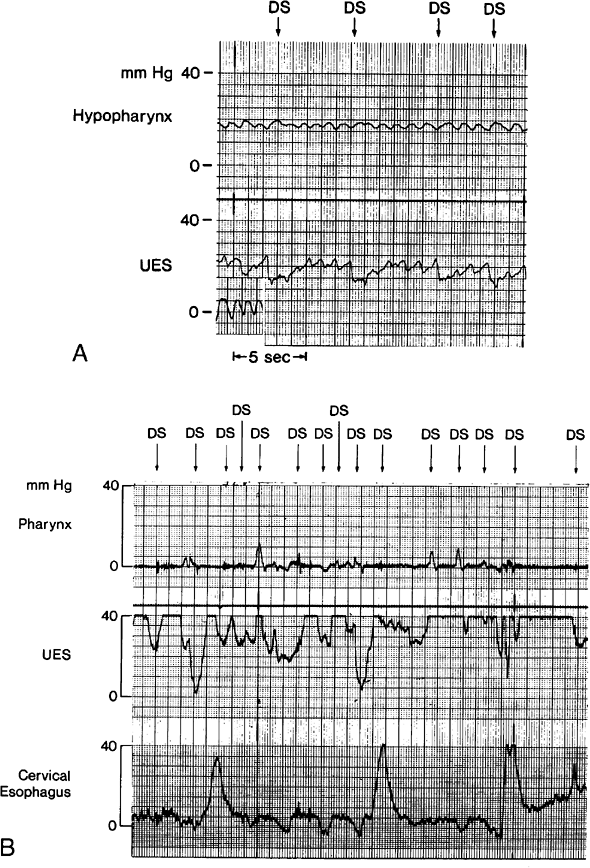 |
Fig. 125-12. A. Neurologic dysphagia. Pharyngeal contraction in response to swallows and relaxation of the upper esophageal sphincter (UES) are absent. B. Note incoordination between pharyngeal contraction and UES relaxation in response to voluntary swallowing. DS, dry swallow. |
P.1914
Muscular disease may affect the pharynx and striated portion of the esophagus. Oropharyngeal dysphagia is present in 65% of patients with oculopharyngeal muscular dystrophy. Weak and repetitive pharyngeal contractions cannot succeed in pushing a food bolus through the UES area (Fig. 125-13). The UES shows normal resting and contracting pressures. We observed (1980) that poor relaxation and poor coordination are seen mostly on video-radiology.
Idiopathic dysfunction of the UES is the diagnosis of choice whenever oropharyngeal dysphagia accompanies significant dysfunction of the UES but without a neurologic, muscular, or other known condition to explain the syndrome. Sutherland (1962) suggested sphincter hypertension in these patients, but the true dysfunction present in this category of dysphagia still awaits clarification.
When idiopathic dysfunction of the UES is accompanied by a pharyngoesophageal diverticulum (Zenker's), the dysfunction that explains the appearance of the diverticulum remains to be specified. Poor relaxation of the UES was reported in radiologic studies. Ellis and Crozier (1981) and Knuff (1982) and our laboratory (1983a) have reported mostly upper sphincter hypotension. Premature closure of the sphincter against the pharyngeal pump action was suggested early to explain the herniated mucosa and submucosa that form a pouch above the UES and through the hypopharyngeal musculature (Fig. 125-14). Cook (1989) and Jamieson (1992) and their colleagues, using sophisticated manometric recordings coupled with video-radiology, documented elevated hypopharyngeal intrabolus pressures with restricted compliance of the UES area during swallowing. This resulted from restrictive fibrosis and inflammation in the excised cricopharyngeus muscle. These pressure abnormalities are corrected by UES myotomy with either suspension or resection of the diverticulum.
Iatrogenic dysfunction of the UES may be found in patients after extensive neck surgery. Laryngectomy causes symptoms in 40% of treated patients. Incomplete UES relaxation as well as incoordination are seen in this group of patients. We have reported (1976) that resting and closing pressures of the UES are significantly lower in laryngectomy patients than in normal subjects.
It is still unclear whether or not the UES responds in a specific fashion in patients with gastroesophageal reflux. This upper sphincter reactivity may be suggested by oropharyngeal dysphagia symptoms, present in 9% of patients with documented reflux disease, as noted by Bonavina and co-workers (1985).
Interpretations of all recordings at the upper esophageal level must take into account the technical difficulties present when studying this radially asymmetric area. Accurate resting and closing pressures can be obtained with the use of circumferential multiport recordings, as suggested by Winans (1972), or of circumferential pressure-sensing transducers, as recommended by Castell and associates (1987). The use of a long perfused silicone sleeve affords the recording of sphincter pressure along the sleeve, even if the sphincter moves around the sensing device.
Idiopathic Motor Disorders
Hypomotility Abnormalities
Achalasia
The motor abnormalities of achalasia are the best known and the most easily recognized of the idiopathic motor disorders. The UES functions normally, but the whole esophagus is otherwise abnormal. In the esophageal body, elevated resting pressures suggest poor esophageal emptying. Voluntary swallowing results in an abnormal contraction response over the whole esophagus: the weak tertiary waves are wide and mirrorlike at every recording level, and these contractions occur in response to every deglutition (Fig. 125-15). The complete absence of peristalsis is a prerequisite of achalasia. The LES of achalasia reveals normal or elevated sphincter resting pressures
P.1915
with a response of incomplete or absent relaxation with swallowing (Fig. 125-16). When a cholinergic agent (urecholine) is administered in low dose to achalasic patients, a denervation response is recorded. Increased activity and pressures are then observed in the esophagus, with stronger contractions in response to swallowing (Fig. 125-17).
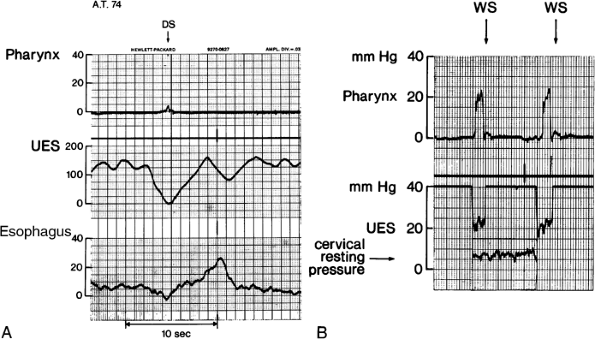 |
Fig. 125-13. A. Muscular disease causing oropharyngeal dysphagia manifests as powerless pharyngeal contraction and normal resting pressure in the upper esophageal sphincter (UES). Although weak, pharyngeal contraction results in UES relaxation. DS, dry swallow. B. In a patient with muscular dystrophy, note the incomplete relaxation of the upper sphincter to cervical esophageal baseline pressure. WS, wet swallow. |
Hypermotility Abnormalities
Diffuse Esophageal Spasm
Symptomatic idiopathic diffuse esophageal spasm is a rare condition. Manometric recording of this functional abnormality must be considered in parallel to the clinical presentation to rule out other conditions that may be responsible for this motor pattern.
 |
Fig. 125-14. Pharyngoesophageal diverticulum. Note incoordination of the upper esophageal sphincter (UES) with premature sphincter closure against the pharyngeal phase of contraction. DS, dry swallow. |
Typically, normal function is found in the proximal esophagus. It is mostly over the smooth muscle portion of the esophagus that abnormal contractions should be expected. When initially described, tertiary contractions that were repetitive and of high amplitude and duration represented the typical abnormalities. Although some normal peristalsis is seen in response to swallowing, most swallows are followed by nonpropulsive, repetitive, and high-pressure waves (Fig. 125-18). Castell (1976) and Richter and Castell (1984) suggested that these contraction abnormalities should be present in 10% to 30% of swallows but in less than 100%. Normal peristalsis should be seen
P.1916
P.1917
occasionally between abnormal contractions. Richter and Castell (1984) observed that elevated contraction pressure need not be present and that spontaneous activity is not part of the diffuse spasm pattern.
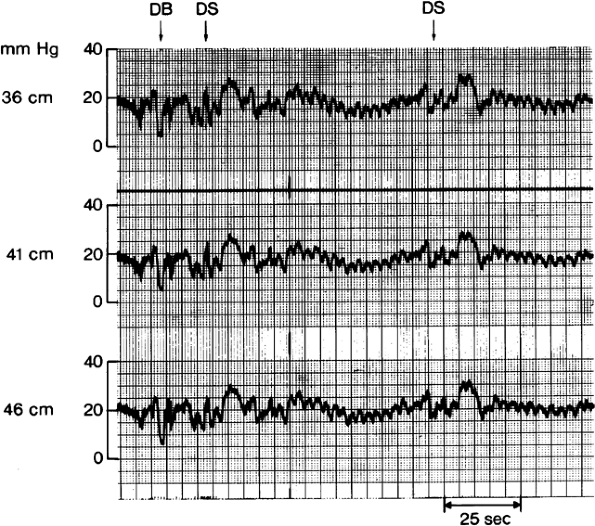 |
Fig. 125-15. Esophageal body in achalasia. Flat, nonperistaltic waves occur in response to all swallows, in both the proximal and the distal esophagus. The elevated resting pressure suggests esophageal retention. DB, dry bolus; DS, dry swallow. |
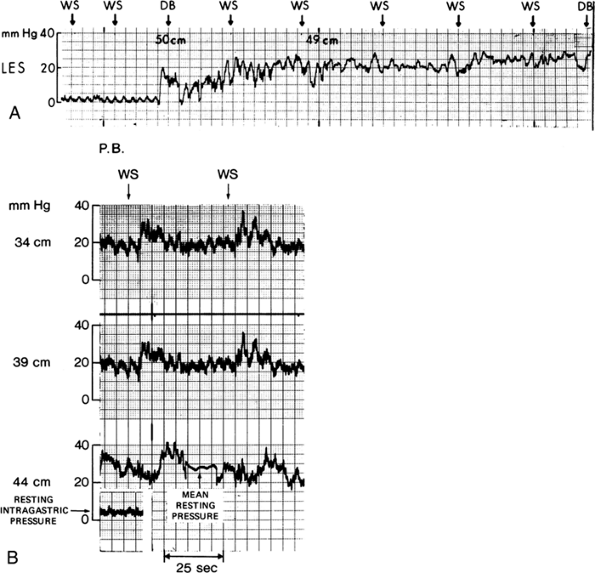 |
Fig. 125-16. Lower esophageal sphincter (LES) function in achalasia. A. The LES zone is entered from the gastric cavity recorded on the left. Incomplete or absent relaxation result with swallows. WS, wet swallow; DB, dry bolus. B. Nonperistaltic contractions in the esophageal body with nonrelaxing LES in response to deglutition. |
 |
Fig. 125-17. Cholinergic stimulation of the denervated esophagus in achalasia causes longer and stronger contractions. The chest pain occurring with these contractions is relieved with atropine. DS, dry swallow; SP, spontaneous contraction. |
 |
Fig. 125-18. Simultaneous contractions with repetitive activity and occasional high-pressure waves in a patient with idiopathic diffuse spasm. DS, dry swallow. |
The LES function in diffuse esophageal spasm patients was considered normal by DiMarino (1974). As noted by Richter and Castell (1984), however, occasional dysfunction can be observed that suggests intermittent abnormalities in the LES with hypertension, incomplete relaxation, or poor coordination (Fig. 125-19).
Idiopathic diffuse spasm of the esophagus does not manifest itself with the clarity of the achalasia motor pattern. Careful recording and correlation with symptoms and radiologic findings should help to narrow down the diagnosis to patients with true dysfunction. Motor disorders secondary to reflux disease or to pathologic infiltration of the esophagus must be ruled out.
Hyperperistalsis (Nutcracker, Supersqueeze Esophagus)
Brand and associates (1977), after describing high contraction pressures in the esophageal body with prolonged peristaltic waves, suggested the term supersqueeze esophagus. Benjamin (1979) and Traube (1984) and their colleagues observed similar abnormalities in patients with noncardiac chest pain. Castell (1987) suggested the term nutcracker esophagus when mean peristaltic pressures exceeded 2 or 3 standard deviations above normal. Mean contraction pressures above 180 mm Hg after 10 swallows should be recorded in these patients. LES function may show normal function with increased resting pressures.
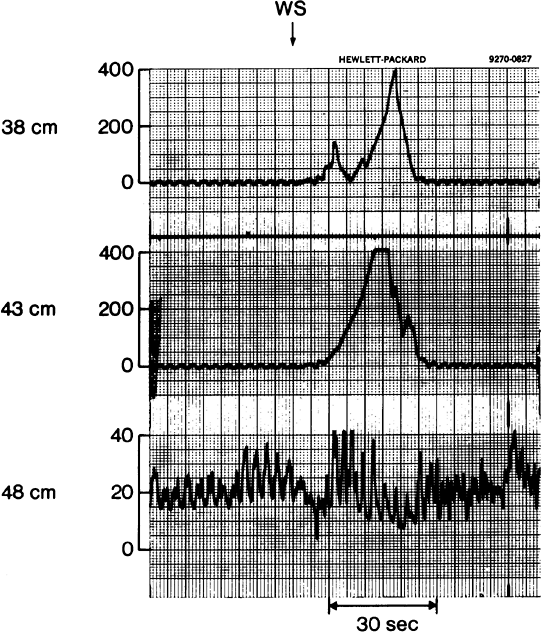 |
Fig. 125-19. Very strong nonperistaltic esophageal contractions and nonrelaxing lower esophageal sphincter in patients with hyperdynamic esophagus accompanying an epiphrenic diverticulum. WS, wet swallow. |
Hypertensive Lower Esophageal Sphincter
Patients showing an LES pressure between 40 and 45 mm Hg are considered to have a hypertensive LES. In these patients, as noted by Code (1960) and Freidin (1989) and their associates, LES relaxation is usually normal, and esophageal body peristalsis is normal.
Nonspecific Esophageal Motor Disorders
The category of nonspecific esophageal motor disorders includes disorders of contraction that cannot be classified as idiopathic hypomotility or hypermotility dysfunction. The vast majority of the patients in this category are considered to have inefficient esophageal motility in response to voluntary deglutition.
P.1918
Motor Disorders of Reflux Disease
Idiopathic Reflux Disease
Atkinson and colleagues (1957) initially documented that LES dysfunction was present when significant reflux occurred in the esophagus (see Table 125-4). Haddad (1970) emphasized that when LES pressures remained weak, reflux episodes occurred more frequently. Ahtaridis and co-workers (1981) further documented a correlation between LES pressures and the potential for reflux. They suggested that any increase in the severity of esophagitis leads to weaker LES pressures. Thus, the first and most significant motor abnormality in reflux disease is weak, or virtually absent, LES pressure (Fig. 125-20). Behar and associates (1974) suggested that when carefully recorded, this documentation probably has value as a prognostic factor in the response to treatment. Ransom (1982), Iascone (1983), and Kahrilas (1986b) and their associates reported that esophageal body dysfunction also tends to increase with increasing damage.
Secondary Reflux Disease
Scleroderma is a well-documented disorder in which esophageal function may become significantly affected. Hurwitz and co-workers (1976) observed that a number of patterns can be identified with this condition, ranging from normal motility and adequate LES to complete absence of esophageal and LES function. Scleroderma patients with absent esophageal defense mechanisms show a higher percentage of severe reflux complications.
The typical scleroderma motor dysfunction reveals intact UES and proximal esophagus activity. In the smooth muscle portion, response to swallowing results in poor-quality contractions with loss of peristalsis. These abnormalities, when associated with complete absence of LES resting pressure, result in constant exposure to gastroesophageal reflux and its eventual complications (Fig. 125-21).
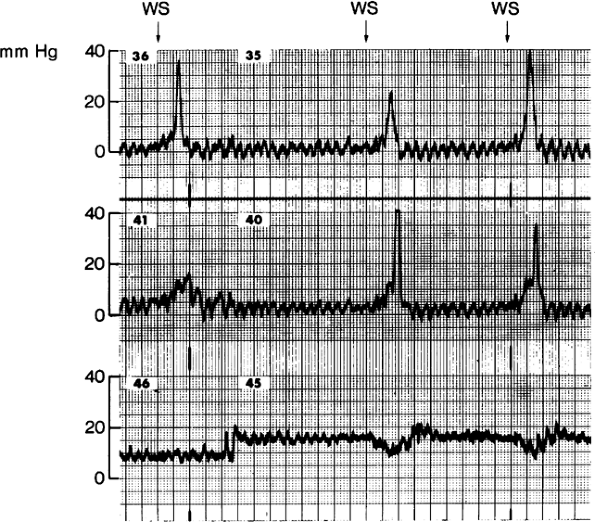 |
Fig. 125-20. The hypotensive lower esophageal sphincter of idiopathic reflux disease. Normal contractions and propulsion are retained in the esophageal body. WS, wet swallow. |
In a similar fashion, the peripheral neuropathy of both diabetic and alcoholic individuals may reduce normal peristalsis and the quality of the normal LES. Patients with these conditions may present with established complications of reflux disease.
MOTILITY STUDIES AS A PROGNOSTIC FACTOR IN REFLUX DISEASE
In one of the early prospective studies looking at the effects of medical and surgical treatment on reflux disease, Behar and associates (1975) documented that when the tone at the LES level is poor, the sphincter shows no changes over time under medical management. More recently, the use of motility studies has been emphasized as an aspect of esophageal function investigation that carries some prognostic value in the management of patients with gastroesophageal reflux. Lieberman (1987), in following patients with reflux esophagitis, found that those who did well with medical management had acceptable values of the LES resting pressures; early relapsers with significant reflux showed low LES pressures. Kahrilas and associates (1986b) reported that patients with increasing reflux damage had significantly weaker LES resting pressure. Progression of mucosal lesions is also accompanied by weaker contractions and by a greater rate of failed peristalsis in the esophageal body. Castell (1991) proposed that at 10 mm Hg and above, LES pressure recordings show much variability, which limits the sensitivity of the test. When the LES
P.1919
pressure is weaker than 6 mm Hg, however, this becomes specific for abnormal reflux. When the tracing shows no recordable sphincter pressure, the probability of severe reflux is high, with a poor prognosis in response to medical treatment.
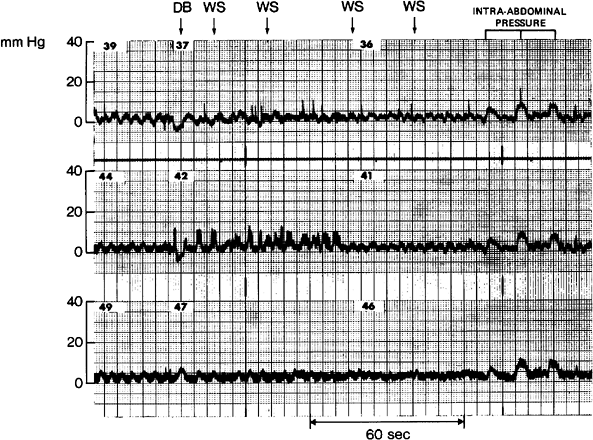 |
Fig. 125-21. Absence of lower esophageal sphincter and esophageal motor activity in patients with scleroderma. Increased intraabdominal pressure (right) is directly transmitted to the intrathoracic esophagus. DB, dry bolus; WS, wet swallow. |
ASSESSMENT OF ESOPHAGEAL SENSITIVITY
Acid Perfusion: Bernstein Test
In 1958, Bernstein and Baker used acid perfusion to induce esophageal pain in patients with reflux disease. The test is based on reproducing symptoms by instilling 0.1 N HCl in the esophagus. The test is performed with the patient sitting and with a nasogastric tube passed 30 cm from the nares. With this tube in place and the patient unaware of the solutions used, infusions are started using normal saline for 15 minutes and then 0.1 N HCl at a rate of 6 mL/min until symptoms are produced.
The test is positive if in two successive infusion periods acid induces pain and saline induces relief. Lazar and associates (1959) proposed that the pain was caused by simultaneous esophageal contractions during the duration of the heartburn from the perfusion. Siegel and Hendrix (1963) came to identical conclusions, documenting increased contraction and strength duration as well as an increased incidence of tertiary contractions (Fig. 125-22).
The specificity of the Bernstein test is 89%, which means that in 100 normal patients with no reflux disease, 11 experience pain during acid infusion, thereby resulting in 11% false-positive test results. Sladen and colleagues (1975) have noted that the sensitivity of the acid perfusion test is low because the pain produced by acid infusion does not correlate with the severity of the esophagitis present.
 |
Fig. 125-22. Esophageal sensitivity as assessed by acid perfusion. Increased incidence and strength of tertiary contractions are observed when acid replaces the water perfusate. The esophagus is cleared by secondary contraction. The response to swallowing under acid perfusion (WS-5) shows a nonpropulsive contraction. SP, spontaneous contraction; WS, wet swallow. |
Acid Emptying Test
The acid emptying test used by Booth and associates (1968) measures the esophageal emptying capacity when exposed to an acid bolus and gives an indication of the adequacy of the esophageal defense mechanisms. A bolus of 15 mL of 0.1 N HCl is introduced into the esophagus 10 cm above the pH probe. The patient performs repeated dry swallows at 30-second intervals. In the normal individual, the distal esophagus is cleared of acid within 10 swallows. A prolonged clearance test indicates an impaired capacity of the esophagus to clear the irritant material from its lumen. Although the early pH studies brought attention to disordered clearance of acid by the esophagus in patients with reflux, this test lacks sensitivity.
Potential Difference Measurements
The transition zone of columnar to squamous epithelium may be accurately defined by measuring potential difference during manometric studies of the area. This measurement is possible by recording a higher potential difference for the esophageal mucosa compared with the negative potential of the gastric mucosa.
Khamis and co-workers (1978) suggested that potential difference measurements may be useful to demonstrate mucosal damage in the absence of endoscopic esophagitis; a reduction in potential difference is present when injury to the esophageal mucosa has been produced. The detection of areas of esophageal columnar epithelium in patients with chronic reflux may represent another advantage.
Orlando (1982) and Herlihy (1984) and their associates reported that specificity for potential difference measurement is 92% to 96%, but sensitivity is only 50% to 70%. When Eckardt and associates (1983) studied histologic findings in esophageal mucosal metaplasia, they found an underestimation of the extent of the pathologic epithelium if it was detected by potential difference measurement.
REFERENCES
Ahtaridis G, Snape WJ Jr, Cohen S: Lower esophageal sphincter as an index of gastroesophageal acid reflux. Dig Dis Sci 26:993, 1981.
Airdar O: Dados sebre a aque tetonica muscular da porcao inicial do esofago humano. Arquiv Cirurg Clin Exp 7:548, 1943.
Arndorfer RC, et al: Improved infusion system for intraluminal esophageal manometry. Gastroenterology 73:23,1977.
Ask P, Tibbling L: Effect of time interval between swallows on esophageal peristalsis. Am J Physiol 238:G485, 1980.
Asoh R, Goyal RK: Manometry and electromyography of the upper esophageal sphincter in the opossum. Gastroenterology 74:514, 1978.
P.1920
Atkinson M, et al: The esophagogastric sphincter in hiatus hernia. Lancet 2:113, 1957.
Behar J, et al: The effect of an anterior fundoplication on lower esophageal sphincter competence. Gastroenterology 67:209, 1974.
Behar J, et al: Medical and surgical management of reflux esophagitis. N Engl J Med 293:263, 1975.
Benjamin SB, Gerhardt DC, Castell DO: High amplitude, peristaltic esophageal contractions associated with chest pain and/or dysphagia. Gastroenterology 77:478, 1979.
Bernstein LM, Baker LA: A clinical test for esophagitis. Gastroenterology 34:760,1958.
Bonavina L, Khan NA, DeMeester TR: Pharyngoesophageal dysfunctions: the role of cricopharyngeal myotomy. Arch Surg 120:541, 1985.
Bonavina L, et al: Length of the distal esophageal sphincter and competency of the cardia. Am J Surg 151:25, 1986.
Booth DJ, Kemmerer WT, Skinner DB: Acid clearing from the distal esophagus. Arch Surg 96:73l,1968.
Boyle JT, Cohen S: Does intrinsic LES tone increase as an adaptive response to increased intraabdominal pressure? Dig Dis Sci 29:760, 1984.
Brand DL, Martin D, Pope CE 2nd: Esophageal manometrics in patients with angina-like chest pain. Am J Dig Dis 22:300, 1977.
Castell DO: Achalasia and diffuse esophageal spasm. Arch Intern Med 136:571, 1976.
Castell DO: The nutcracker esophagus and other primary esophageal motility disorders. In Castell DO, Richter JE, Boag Dalton C (eds): Esophageal Motility Testing. New York: Elsevier, 1987, p. 130.
Castell DO: pH monitoring versus other tests for gastroesophageal reflux disease: Is this the gold standard in ambulatory esophageal pH monitoring? In Richter JE (ed): Ambulatory Esophageal pH Monitoring. New York: Igaku-Shoin, 1991, p. 101.
Castell DO, Richter JE, Boag Dalton C: Esophageal Motility Testing. Elsevier: New York, 1987.
Christensen J: Patterns and origin of some esophageal responses to stretch and electrical stimulation. Gastroenterology 59:909, 1970.
Code CF, et al: Hypertensive gastroesophageal sphincter. Proc Staff Mayo Clin 35:391, 1960.
Cook IJ, et al: Zenker's diverticulum: a defect in upper esophageal sphincter compliance? Gastroenterology 96:A-98, 1989.
Creamer B, Schlegel J: Motor responses of the esophagus to distention. J Appl Physiol 10:498, 1957.
Crist J, Gidda JG, Goyal RK: Intramural mechanisms of esophageal peristalsis: roles of cholinergic and noncholinergic nerves. Proc Natl Acad Sci U S A 81:3595, 1984.
Dent J: A new technique for continuous sphincter pressure measurement. Gastroenterology 71:263, 1976.
Dent J, et al: Mechanism of gastroesophageal reflux in recumbent asymptomatic human subjects. J Clin Invest 65:256, 1980.
Dent J, et al: Interdigestive phasic contractions of the human lower esophageal sphincter. Gastroenterology 84:453, 1983.
DiMarino AJ Jr: Characteristics of lower esophageal sphincter function in symptomatic diffuse esophageal spasm. Gastroenterology 66:1, 1974.
Dodds WJ: Instrumentation and methods for intraluminal esophageal manometry. Arch Intern Med 136:515, 1976.
Dodds WJ, et al: A comparison between primary esophageal peristalsis following wet and dry swallows. J Appl Physiol 35:851, 1973.
Dodds WJ, et al: Quantitation of pharyngeal motor function in normal human subjects. J Appl Physiol 39:692, 1975.
Dodds WJ, et al: Effect of atropine on esophageal motor function in humans. Am J Physiol 240:G290, 1981.
Dodds WJ, et al: Mechanisms of gastroesophageal reflux in patients with reflux esophagitis. N Engl J Med 307:1547, 1982.
Duranceau A, Forand MD, Fauteux JP: Surgery in oculopharyngeal muscular dystrophy. Am J Surg 139:33, 1980.
Duranceau A, Rheault MJ, Jamieson GG: Physiologic response to cricopharyngeal myotomy and diverticulum suspension. Surgery 94:655, 1983a.
Duranceau A, et al: Alteration in esophageal motility after laryngectomy. Am J Surg 131:30, 1976.
Duranceau AC, et al: Esophageal motility in asymptomatic volunteers. Surg Clin North Am 63:777, 1983.
Eckardt JF, Janisch HD, Bettendorf U: Barrett's syndrome: correlation of esophageal morphology with potential difference measurements. Z Gastroenterol 21:199, 1983.
Ellis FH Jr, Crozier RE: Cervical esophageal dysphagia: indications for and results of cricopharyngeal myotomy. Ann Surg 194:279, 1981.
Fisher RS, et al: The lower esophageal sphincter as a barrier to gastroesophageal reflux. Gastroenterology 72:19, 1977.
Freidin N, et al: The hypertensive lower esophageal sphincter. Manometric and clinical aspects. Dig Dis Sci 34:1063, 1989.
Funch-Jensen P, Jacobsen E: Esophageal peristalsis before, during and after food intake in healthy people. Scand J Gastroenterol 16:209, 1981.
Gerhardt DC, et al: Human upper esophageal sphincter: response to volume, osmotic and acid stimuli. Gastroenterology 75:268, 1978.
Haddad JK: Relation of gastroesophageal reflux to yield sphincter pressures. Gastroenterology 58:175, 1970.
Herlihy KJ, et al: Barrett's esophagus: clinical endoscopic, histologic, manometric, and electrical potential difference characteristics. Gastroenterology 86:436,1984.
Hollis JB, Castell DO: Esophageal function in elderly men: a new look at presbyesophagus. Ann Intern Med 80:371, 1974.
Hurwitz AL, Duranceau A, Postlethwait RW: Esophageal dysfunction and Raynaud's phenomenon in patients with scleroderma. Am J Dig Dis 21:601, 1976.
Iascone C, et al: Barrett's esophagus. Functional assessment, proposed pathogenesis, and surgical therapy. Arch Surg 118:543, 1983.
Jamieson GG, Cook IS, Shaw D: The pathogenesis of Zenker's diverticulum and its normalization by cricopharyngeal myotomy. Presented at the 5th World Congress of the International Society for Diseases of the Esophagus, Kyoto, Japan, August 24, 1992.
Kahrilas PJ, et al: Upper esophageal sphincter function during belching. Gastroenterology 91:133, 1986a.
Kahrilas PJ, et al: Esophageal peristaltic dysfunction in peptic esophagitis. Gastroenterology 91:897, 1986b.
Kahrilas PJ, et al: A method for continuous monitoring of upper esophageal sphincter pressures. Dig Dis Sci 32:121, 1987a.
Kahrilas PJ, et al: Effect of sleep, spontaneous gastroesophageal reflux, and a meal on upper esophageal sphincter pressure in normal human volunteers. Gastroenterology 92:466, 1987b.
Kaye MD, Wexler RM: Alteration of esophageal peristalsis by body position. Dig Dis Sci 26:897, 1981.
Khamis B, et al: Transmucosal potential difference, diagnostic value in gastro-oesophageal reflux. Gut 19:396, 1978.
Knuff TE, Benjamin SB, Castell DO: Pharyngoesophageal (Zenker's) diverticulum: a reappraisal. Gastroenterology 82:734, 1982.
Landers BR, Jamieson GG: Response of porcine lower esophageal sphincter to increasing intraabdominal pressure. Dig Dis Sci 32:272, 1987.
Lazar HP, et al: Nonperistaltic esophageal motility accompanying experimental produced heartburn. J Lab Clin Med 54:917, 1959.
Lieberman DA: Medical therapy for chronic reflux esophagitis: long-term follow up. Arch Intern Med 147:1717, 1987.
Liebermann-Meffert D, et al: Muscular equivalent of the lower esophageal sphincter. Gastroenterology 76:31, 1979.
Meyer GW, Gerhardt DC, Castell DO: Human esophageal response to rapid swallowing: muscle refractory period or neural inhibition? Am J Physiol 241:G129, 1981.
Orlando RC, et al: Esophageal potential difference measurements in esophageal disease. Gastroenterology 83:1026, 1982.
Pope CE 2nd: Effect of infusion on force of closure measurements in the human esophagus. Gastroenterology 58:616, 1970.
Ransom JM, et al: Extended and limited types of Barrett's esophagus in the adult. Ann Thorac Surg 33:19, 1982.
Richter JE, Castell DO: Diffuse esophageal spasm: a reappraisal. Ann Intern Med 100:242, 1984.
Rubin J: Measuring the effect of emotions on esophageal motility. Psychosom Med 24:170, 1962.
Sarna SK, Daniel EE, Waterfall WE: Myogenic and neural control systems for esophageal motility. Gastroenterology 73:1345, 1977.
Shipp T, Deatsch WW, Robertson K: Pharyngoesophageal muscle activity during swallowing in man. Laryngoscope 80:1, 1970.
Siegel CI, Hendrix TR: Esophageal motor abnormalities induced by acid perfusion in patients with heartburn. J Clin Invest 42:686, 1963.
Sladen GE, Riddell RH, Willoughby JMT: Oesophagoscopy, biopsy and acid perfusion test in diagnosis of reflux esophagitis. BMJ 1:71, 1975.
Sokol EM, et al: Simultaneous cineradiographic and manometric study of the pharynx, hypopharynx and cervical esophagus. Gastroenterology 51:960, 1966.
Sugarbaker DJ, Rattan S, Goyal RK: Mechanical and electrical activity of esophageal smooth muscle during peristalsis. Am J Physiol 246:G145, 1984.
P.1921
Sutherland HD: Cricopharyngeal achalasia. J Thorac Cardiovasc Surg 43: 114, 1962.
Traube M, et al: Effects of nifedipine in achalasia and in patients with high amplitude peristaltic esophageal contractions. JAMA 252:1733, 1984.
Welch RW, et al: Manometry of the normal upper esophageal sphincter and its alterations in laryngectomy. J Clin Invest 63:1036, 1979.
Winans CS: The pharyngoesophageal closure mechanism: a manometric study. Gastroenterology 63:768, 1972.
Winans CS: Manometric asymmetry of the lower esophageal high pressure zone. Am J Dig Dis 22:348, 1977.
Winship DH, Viegas de Andrade SR, Zboralske FF: Influence of bolus temperature on human esophageal motor function. J Clin Invest 49:243, 1970.
Reading References
Bremner CG, et al: Esophageal motility testing made easy quality. St. Louis: Medical Publishing, 2001.
Castell DO, Richter JE, Boag-Dalton C: Esophageal Motility Testing. New York: Elsevier, 1987.
Hurwitz AL, Duranceau A, Haddad JK: Disorders of esophageal motility. Vol. 16. Major Problems in Internal Medicine. Philadelphia: WB Saunders, 1979.
Richter JE: Ambulatory esophageal pH monitoring. New York: Igaku-Shoin, 1991.
EAN: 2147483647
Pages: 203